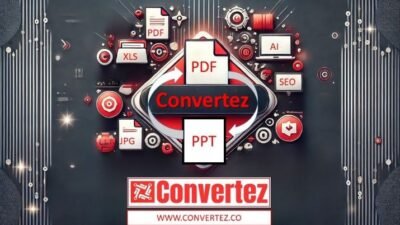In today’s digital age, presentations are one of the most effective ways to communicate ideas clearly and efficiently. But what if you have a PDF document full of valuable content and you want to present it visually? Converting a PDF into a presentation can save time, enhance engagement, and make your content more interactive.
Whether you’re a student, teacher, business professional, or content creator, learning how to turn a PDF into a presentation is a skill worth mastering. In this guide, we’ll walk you through multiple methods to convert a PDF into a presentation with ease, using tools you likely already have access to.
Why Convert a Turn a PDF into a Presentation?
PDFs are excellent for sharing documents in a fixed format, but they’re not ideal for presenting content in a dynamic way. Presentations, on the other hand, offer:
- Visual appeal: Slides can include animations, transitions, and visual elements.
- Clarity: Breaking content into slides makes it easier to digest.
- Interaction: Presentations can include videos, hyperlinks, and embedded media.
- Professionalism: Ideal for meetings, pitches, and classrooms.
By converting a PDF into a presentation, you bridge the gap between document storage and effective communication.
Method 1: Convert PDF to PowerPoint Using Online Tools
The simplest way to Turn a PDF into a Presentation is to use an online conversion tool. These tools automatically extract the content from your PDF and convert it into a PowerPoint (.ppt or .pptx) format.
Step-by-Step Instructions:
- Choose an online converter:
- Convertez PDF to PPT
- Smallpdf
- iLovePDF
- Adobe Acrobat online
- Upload your PDF:
- Navigate to the converter website.
- Upload your PDF by dragging and dropping it into the upload box.
- Convert the file:
- Click on the “Convert” or “Start” button.
- The tool will process the file and generate a downloadable PowerPoint.
- Download your presentation:
- Click the download button to get your .ppt or .pptx file.
- Open it in PowerPoint or Google Slides for further editing.
Pros:
- Fast and user-friendly.
- No software installation needed.
Cons:
- Formatting issues may occur with complex layouts.
- File size limits (on free versions).
- Some tools may add watermarks or require sign-up.
Method 2: Use Adobe Acrobat Pro (Desktop)
If you have Adobe Acrobat Pro, you can convert your PDF directly into a PowerPoint file with just a few clicks.
Steps:
- Open the PDF in Adobe Acrobat Pro DC.
- Click on File > Export To > Microsoft PowerPoint Presentation.
- Choose your destination folder and file name.
- Click Save.
Adobe Acrobat does a solid job of preserving the layout and formatting of your original document.
Pros:
- High-quality conversions.
- Keeps formatting intact.
Cons:
- Requires paid Adobe subscription.
Method 3: Convert Manually by Copying Content
If your PDF includes text and images that you want to customize heavily, you may prefer to manually copy and paste the content into a presentation tool like Microsoft PowerPoint or Google Slides.
How to Do It:
- Open your PDF using a viewer (e.g., Adobe Reader or browser).
- Copy the text and images you want.
- Open PowerPoint or Google Slides.
- Paste the content slide by slide, organizing it visually.
- Format the text, add backgrounds, charts, and animations as needed.
Tips:
- Use pre-made templates to speed up design.
- Group related content on the same slide.
- Add headers and bullet points to enhance readability.
Pros:
- Full creative control.
- Best for customization and reformatting.
Cons:
- Time-consuming.
- Not ideal for large or complex PDFs.
Method 4: Use Google Slides with Google Drive Integration
Google Drive has a built-in PDF viewer, and while it doesn’t convert PDFs directly to Slides, you can use Google Docs to extract the content and then create slides.
Instructions:
- Upload your PDF to Google Drive.
- Right-click on the PDF and select Open with > Google Docs.
- The content will appear in editable format in Docs (though formatting may change).
- Copy the content to Google Slides and arrange it into presentation format.
Pros:
- Free and cloud-based.
- Accessible from anywhere.
Cons:
- Formatting can break, especially with images or complex layouts.
Best Practices for Converting PDFs into Presentations
Regardless of the method you choose, follow these tips to ensure your final presentation is professional and effective:
1. Keep it simple:
Break large text blocks into bullet points. Use visuals to represent complex ideas.
2. Use consistent formatting:
Choose a clean font and consistent style throughout your slides.
3. Highlight key points:
Use bold text, colors, or animations to emphasize important details.
4. Optimize images:
Compress large images for faster loading and better performance.
5. Use slide transitions sparingly:
Keep animations subtle to maintain professionalism.
Recommended Tools for Enhancing Your Presentation
After converting your PDF to a presentation, consider using these tools to enhance it further:
- Canva – For design-focused presentations.
- Visme – For data visualizations and interactive content.
- Lumen5 – Turn your slides into short videos.
- Microsoft Designer – AI-powered design suggestions.
Final Thoughts
Turning a PDF into a presentation doesn’t have to be complicated. Depending on your needs—whether you want a quick conversion or full design control—there are multiple ways to get the job done. Online converters like Convertez.co make the process fast and easy, while manual methods give you creative flexibility.
Before choosing your method, consider:
- The complexity of your PDF layout
- The purpose of your presentation
- How much time you have to customize the slides
Once you’ve converted your file, don’t forget to polish it with consistent formatting, visuals, and a clear message. A well-structured presentation can turn static PDF content into a compelling story.

